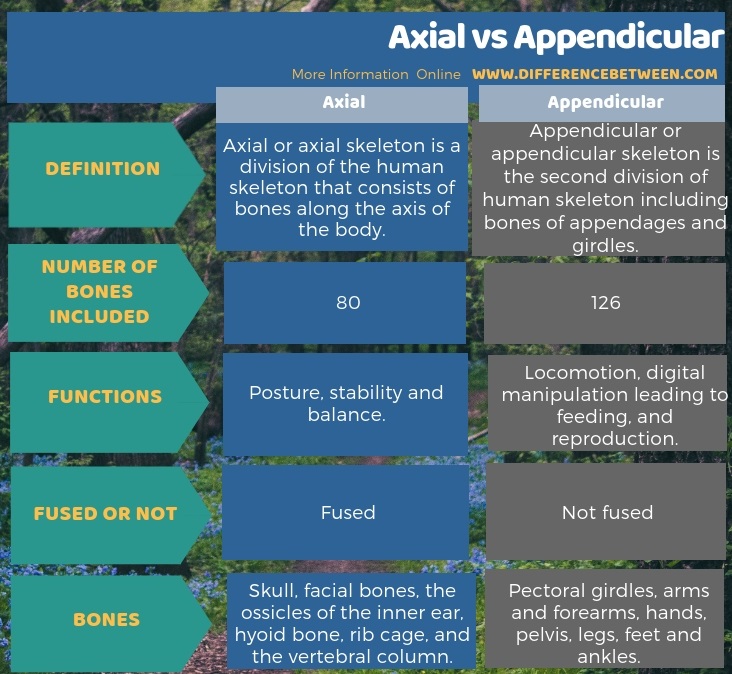The key difference between axial and appendicular skeleton is that the axial skeleton consists of the bones located along the central axis of the body while the appendicular skeleton consists of the bones of the appendages and girdles that connect with the axial skeleton.
The human skeletal system contains individual and attached bones, support of ligaments, muscles, tendons, and cartilages. Hence, the skeletal system performs supportive, protective and locomotive functions. Accordingly, bones are the primary component of the skeleton system that composed of crystallized calcium minerals arranged over and around a protein matrix. Bones help to withstand stress and greater loads on the skeletal system. Based on the anatomy, histology and the functions of the bones, there are several categories of bones. Among them, axial skeleton and appendicular skeleton are two major divisions. Human skeleton system has 206 bones. Among them, there are 80 bones present in the axial skeleton while there are 126 bones on the appendicular skeleton.
CONTENTS
1. Overview and Key Difference
2. What is Axial Skeleton
3. What is Appendicular Skeleton
4. Similarities Between Axial and Appendicular Skeleton
5. Side by Side Comparison – Axial vs Appendicular Skeleton in Tabular Form
6. Summary
What is Axial Skeleton?
The axial skeleton consists of about 80 bones along the central axis of the human body, and it includes the skull (which includes the cranium and the facial bones, the ossicles of the inner ear, hyoid bone, rib cage), and the vertebral column. Moreover, several soft tissues support the axial skeleton. For example, ligaments of the vertebral column, muscles of the face and the throat, cartilage of the ribs, and tendons of the muscles, etc.

Figure 01: Axial Skeleton
Hence, the major functions of the axial are the bearing of the central weight and the protection and maintenance of posture. Accordingly, the skull and the ribcage protect the brain and the organs of the chest cavity respectively. The ossicles of the ear have the function of maintaining the balance of the human body. Similarly, the hyoid bone is an anchor point for various muscles covering the throat as a protective function for the airways, gullet, major arteries and nerves. And also, the vertebral column has functions in proper weight distribution, protection of the spinal cord and maintaining proper posture.
What is Appendicular Skeleton?
The appendicular skeleton consists of 126 bones in the body including the bones of the upper and lower limbs, and their connections to the axial skeleton. All the appendicular skeleton bones are located symmetrically on either side of the body. Therefore, they mainly consist of long bones and other bones. Likewise, the upper arm links with the axial skeleton by the shoulder girdle with the support of a myriad of tendons, cartilages, muscles and ligaments, and the pelvic girdle connects the thigh into axial.

Figure 02: Appendicular Skeleton
Furthermore, the main bones of the upper limb include the humerus, radius, ulna, carpal, metacarpal, and phalanges. The main bones of the lower limb include the femur, tibia, fibula, tarsal, metatarsal, and phalanges. Thus, the functions of the appendicular bones include balance and stability, along with the main functions of locomotion and manipulation.
What are the Similarities Between Axial and Appendicular Skeleton?
- Axial and Appendicular are two divisions of the human skeleton system.
- Both consist mainly of bones.
- Also, both are connected to the muscles.
What is the Difference Between Axial and Appendicular Skeleton?
Axial and appendicular are two divisions of the human skeleton that connected with each other. Their bones have similar basic constituents such as calcium and protein matrix. Both have functions of weight bearing at differing levels, as well as those of stability, balance, and protection of organs. But the key difference between axial and appendicular skeleton is that the axial skeleton is to maintain posture, stability and balance, whereas the appendicular skeleton is to assist in locomotion, digital manipulation leading to feeding, and reproduction.
Also, a difference between axial and appendicular skeleton is the number of bones in each. That is; the axial skeleton has 80 bones whereas, the appendicular skeleton has 126 bones. Furthermore, another difference between axial and appendicular skeleton is that the axial skeleton is fused but, not the appendicular skeleton.

Summary – Axial vs Appendicular
Human skeleton system has two major components namely axial and appendicular. The major difference between axial and appendicular skeleton is that the axial has 80 bones located along the axis of the body while the appendicular has 126 bones of appendages and girdles that are connected to the axial skeleton. Consequently, the main functions of the axial skeleton are supporting the upright position and protecting the internal organs. On the other hand, the main function of the appendicular skeleton is the aiding in the movement of the body.
Reference:
1.“Human Skeleton.” Wikipedia, Wikimedia Foundation, 4 Oct. 2018. Available here
Image Courtesy:
1.”Axial skeleton diagram”By LadyofHats Mariana Ruiz Villarreal – Own work (Public Domain) via Commons Wikimedia
2.”Appendicular skeleton diagram”By LadyofHats Mariana Ruiz Villarreal – Own work, (Public Domain) via Commons Wikimedia
ncG1vNJzZmivp6x7pbXFn5yrnZ6YsqOx07CcnqZemLyue8OinZ%2Bdopq7pLGMm5ytr5Wau26t16KYpWWRo7FuwtJmmKmolaOxqq%2FUpZirZw%3D%3D